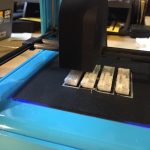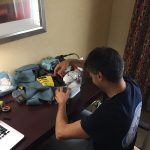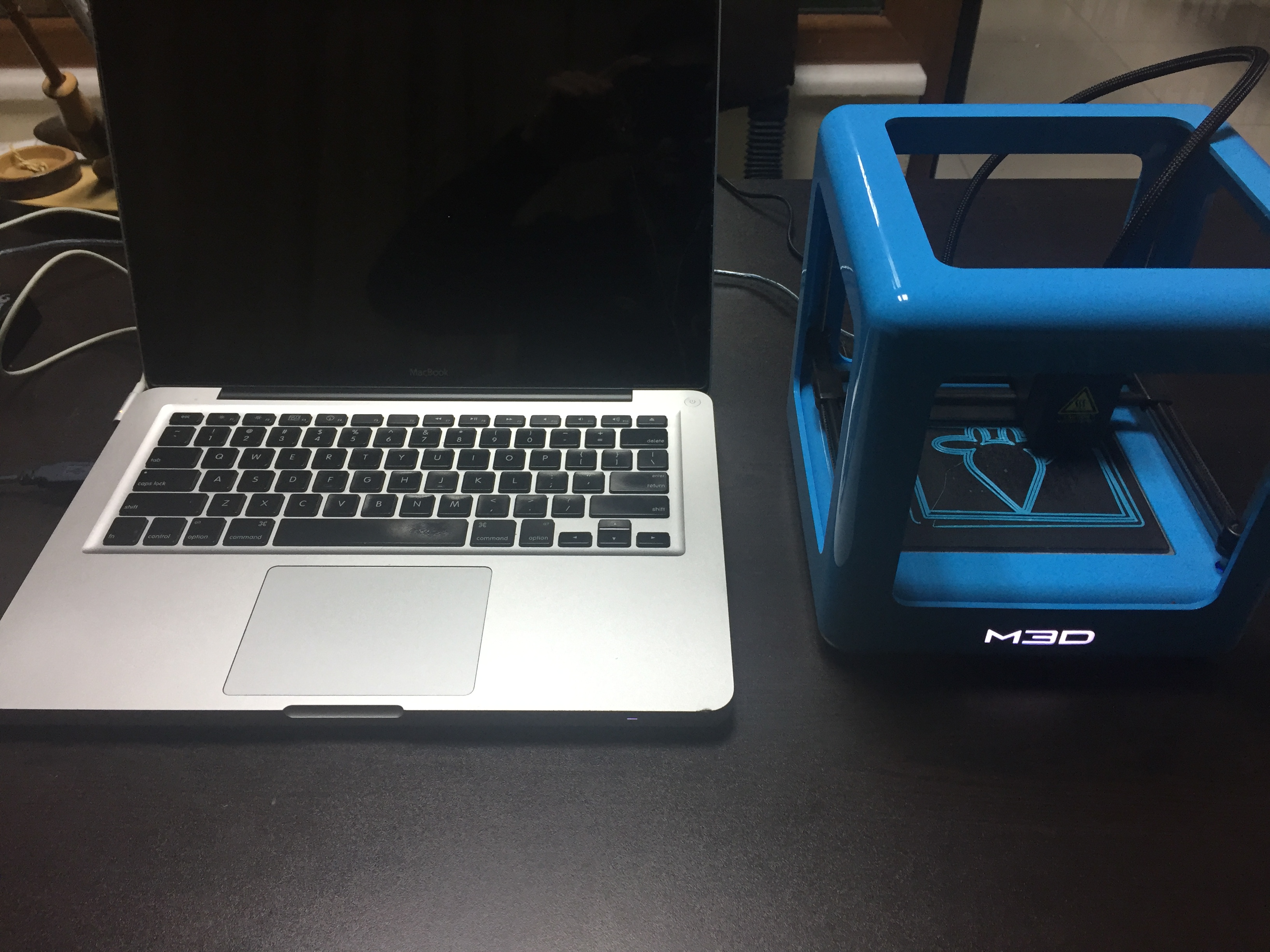Third Vence Field Trip Started

Robolit has arrived sunny California today to conduct the third set of field tests for the Vence cattle herd control system. Our tests will take place at a ranch near San Fransisco—a definite change in climate compared to previous trips in Arizona.

A snapshot from a simulation run where Vence herd management algorithm confines virtual cows in a polygonal virtual fence.
The preamble to this trip was the development of a simulation engine. We constructed a 2D virtual space consisting of cattle and physical fences. We build a simplified cattle behavior model as a combination of basic drives such as hunger, herd instinct and pain avoidance. Within this virtual environment we executed the Vence distributed virtual fence control algorithm to evaluate different strategies and debug the higher level decision making processes.

3D model of the electronics stack in the Vence Collar Prototype 3.
Previous field trips were very informative about cattle farms. These earlier experiments also showed us various ineffective design approaches in the face of realities of a cattle farm. Empowering our team with the addition of an industrial designer our third prototype is more compact, robust and easy to use. We also completely restructured the code base to produce a more streamlined and customizable distributed control architecture.
We are looking forward to running tests and with little luck we will demonstrate the efficacy of the technology we developed for Vence.
Gearing up for 3rd Vence Field Test
We are preparing for the third field trip for the Vence project. We will be in sunny California for this round from April 4th through April 16th. Building on the experience we had gathered in our previous field tests we will be focusing on single and herd level behavioral control of cattle. Bringing in industrial design and web application development expertise the Vence system that will be available in this trip will be more robust and easer to use.
Job Openings Posted
Robolit is gearing up for a very exciting summer. We have lined up several interesting projects and are in the look out for talent to help propel these ideas into reality. Please, check out open positions an let us know if you are interested.
Blurring Lines Between Machine and Biology
The original article can be found on Roboalliance.com. Roboalliance will be discontinued by its founding sponsor, Sharp, on July 2nd, 2018.
In the not too distant simple days of the past, the distinction between a user and his machines was clear. The user, a human, was the master, taking all the decisions, making all the observations and driving machines’ actions at great detail. Machines were essentially sophisticated hammers which would be nothing more than a useless pile of metal and plastic without their user.
Steady improvements in computing and sensing technologies coupled with algorithmic discoveries relating to decision making have transformed machines from passive entities to active partners to humans. With availability of more capable machines and the unrelenting aspiration to achieve ever higher levels of efficiency comes the unavoidable removal of humans from process flows. This shift is in fact not novel at all. Replacement of humans with other agents, may that be a machine and/or an animal, have always taken place to increase productivity. For instance, cows had replaced humans in ploughing farm land many thousands of years ago. An artificial intelligence software replacing the taxi driver today is just the most recent chapter in a long book. This being said, today humans are being pushed out of work flows at such an astounding speed, it presents a major social problem and is starting to cause a small panic. Discussions on the impending technological unemployment problem due to automation and proposed solutions such as Universal Basic Income are some of the downfall of this tectonic shift.
While conversations on the effects of automation on human societies assume mostly dystopian overtones, we at Robolit believe that this is a rather myopic perspective. It is true that the human society of today will cease to exist and most any change is scary, especially for the older crowd. However, the next phase in human evolution, where the historically clear boundary between user and machine will be ever so blurred, will be much more exciting and full of opportunities. In this article we will look into some examples from the global research community as well as some of Robolit projects that signal great potential in this new era.
To see the opportunities in this new era one must change their perspective in some fundamental manner. More specifically, we note that in this new paradigm neither the term user necessarily implies a human, nor a machine has to be an electromechanical system of some sort, nor a top-down decision hierarchy will remain. In contrast to the classical human machine interface literature, where a human is always assumed to be at the top of the decision totem driving collections of artificial systems, we observe this emerging era offers a much richer set of level partnerships between artificial and biological systems.
Historically, and even still today, humans surpass machines in higher level decision making in most any practical scenarios. For this very reason we are accustomed to having humans assume the decision making role. However, the steady rate of progress in decision making heuristics in general and artificial intelligence in particular suggests that in the near future computers will come on par with, and may be even exceed, their human counterparts in this area. Applications in our daily life such as natural language processing, autonomous driving and face recognition are just a few examples showing signs of this inevitable future.
This being said the fast paced developments in the information processing capabilities are not quite matched in other aspects of general machine design. Most notably physical capabilities such as dexterous interaction with objects or locomotion in broken and unstable natural settings are lacking in contemporary systems. Undoubtedly, machines will eventually achieve physical qualities that match biological systems. However, it is clear that the rate of improvement in physical capabilities is significantly lower than that of information processing capabilities. Consequently, we note that there will be a time period where artificial systems will provide high level of intelligence while lacking physical capabilities. We believe this is where the next family of killer applications.
There are numerous examples in the global research arena beautifully demonstrating the potential in proper integration of artificial and biological agents. For instance, work by David Eagleman demonstrates that the flexible nature of neural systems in humans can be taken advantage of to introduce new sensory capabilities that are not available in our nature. New perspective, faster access to information, deeper understanding of big data with assistive analysis software are just some of the new super powers this marriage between biology and technology will offer us humans.
Inspired by this observation, at Robolit, we identified a unique opportunity for a novel human machine partnership where computers take on high dimensional information processing and decision making tasks while humans perform physical tasks in the field as identified by computers. A specific example for this operational model is the Hotel Operation System (hOS) under development in partnership with Drita Hotel Resort & Spa. The core of this system is a data center that is tied to numerous information sources across the hotel grounds, automatic IoT collected as well as manually entered by human operators. A family of artificial intelligence software applications constantly process incoming data streams and produce decisions. In turn, these decisions are relayed to proper employees through their smart phone and/or tables to be physically executed. For instance, room check outs at the front desk directs housekeeping to clean the room and guest relations to contact the guest to apply the exit survey. Elimination of middle management provides significant cost reduction and improved speed and follow through improves user experience. In essence, the employees act as remote manipulators and sensors for the central computer and decision making software. This approach improve upon shortcomings of human decision making process while avoiding the need to develop robotic systems that are extremely costly at this moment in time.
Another novel example for machine/biology partnership can be observed in the developing cattle management system by the Vence Corp—another project Robolit has the opportunity to participate as a technology partner. In its core the Vence system aims to influence the swarm behavior of cattle herds in order to move animals across their pasture to achieve optimal grazing. While in its initial incarnation the Vence system is yet another master/slave type controlled biological system application, in the long term a Vence powered cattle will be a free range animal that is granted extra sensations and instinctual drives enabling it to find the best grass in its environment. Much like the hOS powered hotel employees or David Eagleman’s vibrating jacket wearer, the cattle of the future in the Vence architecture, a non-human biological user, will take advantage of new senses technological integration offers and be fed better and live more freely.
Our final example for advantageous partnership opportunities between biological and artificial systems is the Sharp’s Intellos automated unmanned ground vehicle (A-UGV). While at the first glance the Intellos system is a simple mobile security camera, that is indeed just the tip of the complete solution that is offered by Sharp. The essence of the Intellos system is based on the very same observations that the previous hOS and the Vence examples take advantage of, i.e., augmenting humans’ with powerful data gathering and decision making capabilities while taking advantage of humans where they still exceed their artificial counterparts. Allowing a single security person to be at multiple points at the same time and process tens of video streams simultaneously to identify what requires in person attention is the competitive advantage Intellos offers.
The convergence of various fields and the ubiquitous availability of computational power, communicational bandwidth and freely available algorithmic mechanism will open up new avenues for marrying biological systems with artificial capabilities. We like it or not the merging between us and machines has already began with the smart phones. It is important to identify the “good” partnerships that enrich our lives. Just like 90’s animated gif ridden bad web site designs, not all applications of a technological paradigm produces good products. It is our job as creators of the future to build the clean and functional marriages between nature and machine.
All Vence Team meets at the Ranch
 The entire Vence team gathers at the Hecianto Corona, the ranch where we will be conducting our experiments for the second field trip in the coming week. The desert is rather cold in the mornings but fortunately gets quite pleasant as hours pass.
The entire Vence team gathers at the Hecianto Corona, the ranch where we will be conducting our experiments for the second field trip in the coming week. The desert is rather cold in the mornings but fortunately gets quite pleasant as hours pass.

We have setup a small herd of five cattle with our brand new experimental collar in a medium size corral. Our experiment management station has a perfect vantage point allowing us to observe the herd behavior without disturbing the animals.
Pulling All Nighters at the Temporary Workshop
 No field test is complete without pulling a few all nighters. We discovered a few issues with our experimental collar design in the first day at the ranch. The entire team is hard at work to apply the necessary changes before the next set of tests.
No field test is complete without pulling a few all nighters. We discovered a few issues with our experimental collar design in the first day at the ranch. The entire team is hard at work to apply the necessary changes before the next set of tests.
We setup a temporary workshop at a hotel near by the ranch where we will be conducting experiments. At this home away from home we have all any hacker would need from 3D-printers to sawing machines.
temporary workshop at a hotel near by the ranch where we will be conducting experiments. At this home away from home we have all any hacker would need from 3D-printers to sawing machines.
Vence Field Test #2 Starts
 After a busy three day preparation the second Vence prototype development field trip started. We are at a new ranch in Negoles, Arizona, USA for this work.
After a busy three day preparation the second Vence prototype development field trip started. We are at a new ranch in Negoles, Arizona, USA for this work.  Our tests will look into both individual and group level behavioral responses to stimulation. In the first day of this nine day trip we tested our brand new cattle collar containing our sensor package and stimulation system.
Our tests will look into both individual and group level behavioral responses to stimulation. In the first day of this nine day trip we tested our brand new cattle collar containing our sensor package and stimulation system.








